My garden has always been my sanctuary, a place of vibrant color and peaceful routine. That’s why I was so intrigued one morning when I spotted a cluster of tiny, pearl-like spheres nestled in the soil. They were perfectly round, with a soft, almost magical glow. My first thought was that a necklace had broken, or perhaps my children had been playing with marbles. But a closer look revealed something more organic, more mysterious. They were nestled too perfectly in the earth to be anything but a part of the garden itself.
Driven by curiosity, I carefully dug a few out. They felt soft and gelatinous, unlike any seed or stone I’d ever encountered. Holding one up to the light, I could see tiny, dark specks suspended inside. A slow realization dawned on me: these weren’t pearls or beads; they were eggs. The romantic mystery of the moment quickly gave way to a practical concern. In a garden, unidentified eggs are rarely a good sign. Were they from a beneficial creature, or a future pest that would devour my tender plants?
A quick search online provided the answer: snail eggs. The term “snail caviar” sounded almost charming, but the reality for a gardener is far less appealing. Snails can decimate a garden overnight, munching through leaves, flowers, and vegetables with alarming speed. Furthermore, some snails can carry parasites, making them a potential health risk. My beautiful, mysterious pearls had transformed into a looming problem. The delicate orbs were a nursery for hundreds of future garden invaders.
I knew I had to act to protect the plants I had worked so hard to nurture. I returned to the garden with a pot of boiling water and carefully poured it over the entire cluster, ensuring the eggs would not hatch. I then conducted a thorough inspection of the surrounding area to find and remove any other hidden clutches. That day, I learned a valuable lesson in vigilance. A garden is a complex ecosystem, and beauty can sometimes be deceptive. Now, I always look a little closer, understanding that the greatest threats to a garden are often small, hidden, and deceptively pretty.
